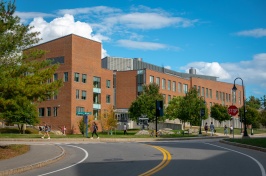When UNH glaciologist Mark Fahnestock heads north to conduct field research on the Greenland ice sheet, he travels 2,300 miles up and 10,000 years back. Dropped by helicopter to camp in tents on the rocky shoreline near the Jakobshavn Isbrae glacier outside the town of Ilulissat, Fahnestock and his colleagues are on the edge of a 630,000-cubic-mile sheet of ice that blankets the world's largest island in all directions--a living remnant of Earth's last ice age.
A mere fraction of the massive ice sheet, Jakobshavn fills a Grand Canyon-sized chasm with ice over a mile and a half thick. It gives birth to 35 billion tons of icebergs every year as its 4-mile-wide front "calves" chunks into the Jakobshavn Icefjord. Some of the icebergs are so large that one laid on its side would squash the UNH campus end to end under thousands of feet of ice. Five years ago this great wall of ice, which had moved at a stately 65 feet per day for half a century, suddenly quickened its slide towards the sea. Today, Jakobshavn moves 130 feet, or nearly half a football field, per day. Other Greenland glaciers, including two as large as Jakobshavn, have also doubled their speed, and no one knows exactly why.
 DOUBLE TIME: Glaciologist Mark Fahnestock hopes to find out why Greenland's glaciers have begun melting at a rapid pace. |
To shed light on this phenomenon and determine what it might mean for our planet's future, Fahnestock and his fellow scientists make two annual, month-long pilgrimages to Jakobshavn, deploying Global Positioning System receivers to gauge its movement. Fahnestock will return in May to retrieve data collected by the instruments, which were strategically placed to travel a year on the flowing river of ice without--it is hoped--pitching into a crevasse or getting drowned in a surface lake along the way.
Fahnestock, who relishes getting back on the ice, will be right at home--in a primordial sort of way. "The area around Jakobshavn is a rocky, treeless coastline that looks exactly like New Hampshire's would have after the ice sheet retreated 10,000 years ago," he says. It is a pristine landscape of stark beauty with a palpable connection to the "deep time" of Earth's glacial history, which goes back millions of years through a series of major ice ages.
Fahnestock himself has a keen sense of this deep time--it's in his blood. He spent virtually every summer of his childhood camped out in remote regions across North America while his father studied glacial deposits and streams. Glacial till was the boy's sandbox, and when Fahnestock describes the immense flowing, grinding, cracking, calving, sky-blue rivers of ice that are now his quarry, you sense that these are indeed living organisms.
But despite our planet's long glacial history and its extraordinary load of ice, which still covers more than one-tenth of its surface, the earth's "cryosphere" is about as tangible in most people's minds as the ice-laden surfaces of Neptune. "It's hard for people to connect to the ice, I think, because it's so far away," Fahnestock says before pausing and adding, "Well, it seems like it's so far away."
In fact, what's happening to Jakobshavn and other glaciers worldwide is as close as the waves lapping at our coastlines. Jakobshavn is an "outlet glacier," meaning that it drains a portion (6.5 percent) of the massive Greenland ice sheet. Jakobshavn and its sister outlet glaciers dump vast quantities of icebergs and freshwater into their fjords and, thus, the world's oceans. The end result of this dribbling away of Earth's glaciers will be a slow rise in sea levels and a change in ocean circulation patterns due to lower water salinity and density.
 |
Jakobshavn's current rate of melting is a fraction of a percent of the potential decay of the entire Greenland ice sheet: if it completely melted, it would raise the global sea level by 23 feet. Today's rate, however, is no match for the past. At the end of the last ice age, so much of the earth's ice melted that sea levels rose 300 feet in just 3,000 to 4,000 years. But in addition to not knowing why the Greenland glaciers have suddenly doubled their speed, scientists are unclear if this behavior represents a periodic, controlled release or is the beginning of a massive "dam" failure. "We don't have a way to predict how large these changes are going to be," Fahnestock says. "We have no way of knowing if the whole glacial system near the coast will have the capacity of holding back all the ice that's behind it. But we do know that there is no reason these systems have to be stable, and there's good reason to think they can change fairly quickly. What's to keep them from tripling their speed?"
Ten years ago, Fahnestock says, had any reputable scientist stood up at a scientific meeting and predicted that three of Greenland's largest outlet glaciers would suddenly, inexplicably make a dash for the sea, they would have been hooted from the hall. And while he's concerned that human-induced climate warming may have triggered a runaway break in the dam, he is enthralled, from a scientific point of view, by the challenge of trying to hit a moving target.
"Almost all the ice on earth is on the move in one way or another." With a smile he adds, "We live in interesting times."
Fahnestock's office within the Complex Systems Research Center at the UNH Institute for the Study of Earth, Oceans, and Space appears to have undergone its own epoch of glacial retreat, leaving an "outwash plain" of debris behind. Stratified stacks of papers flow across desk surfaces, buttes of cardboard boxes rise from the floor, and a melange of computer gadgetry, power cords and hardware sprawl like glacial till in a jumble of comfortable disaster. A small pathway snakes through the rubble to his desk chair.
Inside his office, Fahnestock's long, bony frame hunches in front of one of several laptops and computer monitors as he puzzles over satellite imagery from polar regions or cobbles together videos from a profusion of digital photographs taken in the field. In one video he's created, an iceberg the size of four city blocks rolls on its side and spawns a 1,000-foot-high wave.
That his office resembles glacial chaos is, perhaps, testament to Fahnestock's desire not to be holed up inside but rather perched atop Jakobshavn or camped out at its base--preferably with his wife, Judy, and their two young sons. But, alas, times have changed from days of yore when scientists could take their families with them into the field for a summer of research.
Fahnestock spent two summers in his childhood home of Fredonia along the glacially excavated shoreline of Lake Erie in upstate New York. Every other summer, he, his mother and his older brother would travel hither and yon across North America and rough it while the elder Fahnestock, a geomorphologist and college professor, conducted his research in places like British Columbia, Alaska, Mount Rainier and the Colorado Rockies.
That lifestyle came to a sudden halt when, during Fahnestock's senior year in high school, his father was killed in a plane crash while visiting a pilot friend in Colorado. "They were just going out looking at the mountains," Fahnestock says. "He flew in a lot of little planes. I fly in little planes, and right now I'm flying in helicopters. But that's how you get to these places."
Greenland, a self-governing island dependency of Denmark, is the world's largest island and has one of the smallest national populations. Some 56,000 people, largely of Inuit heritage, occupy a small fraction of the ice-bound, 1.3-million-square-mile country. Population centers cling to a thin ribbon of ice-free coastal areas. Ilulissat, a Greenlandic word meaning "The Icebergs," has a population of around 4,000, is the country's most popular tourist destination, and has helicopter service out to Jakobshavn Isbrae for sightseeing and scientific derring-do.

Fahnestock, along with Martin Truffer, Roman Motyka and Jason Amundson from the University of Alaska, Fairbanks, has been flying over and onto Jakobshavn for two years in an effort to piece together the puzzle of its recent surge forward and its dramatic drop in elevation. In addition to doubling its speed in the last five years, Jakobshavn and some other big outlet glaciers have thinned from top to bottom at a rate of 30 to 50 feet per year.
Fahnestock explains, "Because the ice is flowing so much faster, it's also getting stretched, and this causes the glacier to drop and pull ice from the sides into the main channel."
Jakobshavn's change of pace could be related to the disappearance of a floating "tongue" of ice that had long choked the fjord but ripped loose in 2002 and 2003 and floated away. Jakobshavn in turn picked up speed. Did the tongue of ice act as a cork in the bottle? Or did Jakobshavn shove it out of the way as it picked up momentum? Could it be connected to warmer ocean waters and a warmer atmosphere? It's a chicken-egg situation with many dimensions, says Fahnestock.
So the ice mountain is simultaneously flowing downhill, shrinking in height, shedding icebergs off its front end and receding upwards toward the main ice sheeta--all of which makes it challenging for scientists in a helicopter to know where to land safely. What's more, due to the scale of these white behemoths, the view from above can be hard to decipher.
Peering at a satellite image of Jakobshavn taken by an instrument aboard NASA's Terra satellite, Fahnestock notes, "These are huge systems. The glacier here is nearly four miles wide. When you're up in a helicopter, it's almost impossible to know you're in the middle of it."
 CHILLY CAMPGROUND: Scientists catch a ride on a helicopter to the Jakobshavn glacier in Greenland and then camp for a month at a time while conducting research. CHILLY CAMPGROUND: Scientists catch a ride on a helicopter to the Jakobshavn glacier in Greenland and then camp for a month at a time while conducting research. |
From their base camp, it takes 20 minutes via helicopter to reach the territory where they deploy the four "permanent" receivers to take readings for a full year. Twice as many temporary receivers are also deployed. The four permanent instruments will record whether the glacier moves in response to the explosive calving episodes, in which ship-sinking chunks of ice shear off its face. The scientists hope that this will provide insight into the connection between what happens at the glacier's front end and the speed at which it's flowing upstream, giving them a better idea how well the glacier is connected to its bed. The field data should, in theory, help reveal how this process varies through the seasons and shed light on what the future holds should the Arctica's current warming trend rule the day.
"If the whole glacier itself--the bottom 20 miles--is sensitive to changes at the front end," says Fahnestock, "then there's a good chance the whole lower part will go at some point, the calving face will migrate well inland, and the process could continue to accelerate."
But Earth's vacillating climate and its effect on big systems like glaciers are not an easy read, and Jakobshavn alone has many surprising chapters. During long periods of both warming and cooling, like the Medieval Warm Period (10th to 14th centuries) and the Little Ice Age (16th to 19th centuries), the world's glaciers seesawed back and forth between recession and stability.
As the Little Ice Age came to a close around 1850, Jakobshavn, as Fahnestock puts it, was a "happy glacier," settled as it was into a good stretch of stability. Then the planet warmed again. Says Fahnestock, "At that point, Jakobshavn started retreating till the 1930s. It stabilized for another 50 years, and now it's retreating like mad."
Today's measurably warmer climate, producing tepid ocean temperatures that gnaw at the bottom of big, tidewater outlet glaciers like Jakobshavn, would seem to be the obvious reason for this mad retreat. But perhaps 8,000 to 10,000 years ago, Fahnestock postulates, Jakobshavn was behaving this very same way. "Maybe what we're seeing now is the glacier continuing to respond to the end of the ice age."
Just two hundred years ago, Earth's ice ages were unknown to scientists. Evidence of glacial action--polished and scraped bedrock, huge erratic boulders, for example--was thought to be the result of diluvianism, belief that they were artifacts of the great flood of the Bible.
Humankind has come a long way in understanding the complex inner workings of our home planet. At the same time, we ourselves have become a geologic force. Perhaps Jakobshavn's current behavior is just a cyclical phenomenon, or perhaps what's happening now is but a tiny perturbation compared to what's in store for a warming planet. Whatever the case, it's up to scores of scientists like Fahnestock to tease answers out of these big, complex systems so that we can more wisely direct our newfound, globe-changing powers and chart a sustainable path to the future of life on Earth.
David Sims '81 is the science writer for the UNH Institute for the Study of Earth, Oceans, and Space.


















































